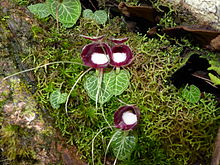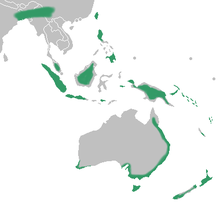Corybas (plant)
| Helmet orchids | |
|---|---|

| |
| Corybas pictus - a South-East Asian species | |
| Scientific classification | |
| Kingdom: | Plantae |
| Clade: | Tracheophytes |
| Clade: | Angiosperms |
| Clade: | Monocots |
| Order: | Asparagales |
| Family: | Orchidaceae |
| Subfamily: | Orchidoideae |
| Tribe: | Diurideae |
| Subtribe: | Acianthinae |
| Genus: | Corybas Salisb.[1] |

| |
| Corybas range map | |
| Synonyms[1] | |
| |
Corybas, commonly known as helmet orchids, is a
Description
Orchids in the genus Corybas are perennial, deciduous,
The flower has a short stalk with a small, leaf-like

Taxonomy and naming
Corybas aconitiflorus was first formally described by Richard Salisbury, allegedly from a colour plate prepared by Ferdinand Bauer[2] and thus became the type species for the genus. The description was published in The Paradisus Londinensis.[8][9] Salisbury stated that the name of the genus was derived from similarity of the flowers to the covered head of the Greek Κορύβας (Korybas),[10] a male dancer, shown in illustrations wearing a crested helmet, who worshipped the goddess Cybele. Korybas was a priest of Cybele, "whose religious rites were accompanied by frenzied music and dancing".[11] A 2002 revision of Corybas split it into numerous genera,[12] but this is not widely accepted.[13][14]
Ecology
Pollination appears to be achieved by small insects, possibly mistaking the unusual flowers for fungi.[2][15] Helmet orchids have not often been studied, partly because of their short-lived, inconspicuous flowers but also because the flowers are difficult to preserve as herbarium specimens. Many form clonal colonies but it is not known whether this is a characteristic of all species.[3]
Distribution and habitat
Helmet orchids grow in India, South China, Taiwan, the Malay Peninsula, Borneo, the Philippines, New Caledonia, Vanuatu, Ponape, Indonesia, New Guinea, the Solomon Islands, Australia (including Macquarie Island), New Zealand (including Chatham, Stewart, Auckland and Campbell Islands), Tahiti, Samoa and the Society Islands. Australian species usually grow in moist, shady places, often with dense moss or on rotting logs, sometimes with orchids from other genera.
Gallery
-
Corybas pictus 1863 illustration from Curtis's Botanical Magazine
-
Vic. and Tas.
-
Slaty helmet orchid C. incurvus from N.S.W., Vic, Tas. and S.A.
-
C. recurvus from W.A.
Species
As of July 2020[update], the World Checklist of Selected Plant Families accepts the following species and natural hybrids:[16]
- Corybas abditus D.L.Jones - swamp helmet orchid, small helmet orchid (W.A.)
- Corybas abellianus Dockrill - nodding helmet orchid (Qld.)
- Corybas aberrans P.Royen (New Guinea)
- Corybas aconitiflorus Salisb. - cradle orchid, spurred helmet orchid (Qld., N.S.W., Vic., Tas.)
- Corybas acuminatus M.A.Clem. & Hatch - dancing spider orchid, helmet flower (N.Z.)
- Corybas acutus J.Dransf. & J.B.Comber (Java)
- Corybas aduncus (Schltr.) Schltr. (New Guinea)
- Corybas albipurpureus P.Royen (New Guinea)
- Corybas amabilis P.Royen (New Guinea)
- Corybas amungwiwensis P.Royen (New Guinea)
- Corybas annamensis Aver. (Vietnam)
- Corybas arachnoideus (Schltr.) Schltr. (New Guinea)
- Corybas arfakensis (J.J.Sm.) Schltr. (New Guinea)
- Corybas aristatus (Schltr.) Schltr. (New Guinea)
- Corybas autumnalis A.P.Br. & D.Edmonds (Southwest Australia)
- Corybas bancanus (J.J.Sm.) Schltr. (Sumatra)
- Corybas barbarae D.L.Jones - fairy lanterns (Qld., N.S.W.)
- Corybas betchei (F.Muell.) Schltr. (Samoa)
- Corybas betsyae P.Royen (New Guinea)
- Corybas boridiensis P.Royen (New Guinea)
- Corybas bryophilus J.J.Sm. (Borneo)
- Corybas calcicola J.Dransf. & G.Sm. (Malaysia)
- Corybas callifer (J.J.Sm.) Schltr. (New Guinea)
- Corybas calopeplos J.Dransf. & G.Sm. (Malaysia)
- Corybas calophyllus (Schltr.) Schltr. (New Guinea)
- Corybas carinatus (J.J.Sm.) Schltr. (Malesia)
- Corybas carinulifer (Schltr.) P.Royen (New Guinea)
- Corybas carsei (Cheeseman) Hatch - swamp helmet orchid (N.Z.)
- Corybas caudatus Holttum (Malaysia)
- Corybas cerasinus D.L.Jones & B.Gray - red helmet orchid (Qld.)
- Corybas cheesemanii (Hook.f. ex Kirk) Kuntze - Cheesemans spider orchid (N.Z.)
- Corybas circinatus Tandang & R.A.Bustam.
- Corybas comptus J.Dransf. & G.Sm. (Malaysia)
- Corybas confusus Lehnebach - spider orchid (N.Z.)
- Corybas crenulatus J.J.Sm. (Borneo)
- Corybas cryptanthus Hatch - hidden spider orchid, icky (N.Z.)
- Corybas cyclopensis P.Royen (New Guinea)
- Corybas cymatilis P.Royen (New Guinea)
- Corybas dentatus D.L.Jones - Lofty Ranges helmet orchid (S.A.)
- Corybas despectans D.L.Jones & R.C.Nash - tiny helmet orchid, sandhill helmet orchid (S.A., Vic., W.A.)
- Corybas diemenicus (Lindl.) Rupp - stately helmet orchid (N.S.W., A.C.T., Vic., Tas.)
- Corybas dienemus D.L.Jones - windswept helmet orchid (Macquarie Island)
- Corybas diversifolius S.P.Lyon (Papua New Guinea)
- Corybas dowlingii D.L.Jones - red lanterns (N.S.W.)
- Corybas ecarinatus Anker & Seidenf. (Thailand)
- Corybas echinulus E.Faria (New Caledonia)
- Corybas ekuamensis P.Royen (New Guinea)
- Corybas epiphyticus (J.J.Sm.) Schltr. (New Guinea)
- Corybas erythrocarpus J.J.Sm. (New Guinea)
- Corybas expansus D.L.Jones - flared helmet orchid (S.A.)
- Corybas fanjingshanensis Y.X.Xiong (China)
- Corybas fenestratus P.Royen (New Guinea)
- Corybas fimbriatus (R.Br.) Rchb.f. - fringed helmet orchid (Qld., N.S.W., Vic., Tas.)
- Corybas finisterreanus S.P.Lyon (P.N.G.)
- Corybas fordhamii (Rupp) Rupp - banded helmet orchid (Qld., N.S.W., Vic., S.A., Tas.)
- Corybas fornicatus (Blume) Rchb.f. (Western Malesia to Bali)
- Corybas gastrosiphon (Schltr.) Schltr. (New Guinea)
- Corybas geminigibbus J.J.Sm. (Southeast Asia)
- Corybas gemmatus P.J.Cribb & B.A.Lewis (Solomon Islands)
- Corybas gibbifer (Schltr.) Schltr. (New Guinea)
- Corybas globulus (D.L.Jones & L.M.Copel.) J.M.H.Shaw (N.S.W.)
- Corybas x halleanus E.Faria (New Caledonia)
- Corybas hatchii Lehnebach
- Corybas helensis S.P.Lyon (Papua New Guinea
- Corybas himalaicus (King & Pantl.) Schltr. (east Himalayas to Assam)
- Corybas hispidus D.L.Jones - bristly helmet orchid (Qld., N.S.W., Vic.)
- Corybas holttumii J.Dransf. & G.Sm. (Malaysia)
- Corybas huonensis S.P.Lyon (P.N.G.)
- Corybas hypogaeus (Colenso) Lehnebach
- Corybas imperatorius (J.J.Sm.) Schltr. (Java)
- Corybas incurvus D.L.Jones & M.A.Clem. - slaty helmet orchid (N.S.W., A.C.T., Vic., S.A., Tas.)
- Corybas insulifloris P.Royen (Flores)
- Corybas iridescens Irwin & Molloy - spider orchid, big red (N.Z.)
- Corybas karkarensis P.Royen (Karkar Island)
- Corybas karoensis J.B.Comber & J.Dransf. (Sumatra)
- Corybas kinabaluensis Carr (Sabah)
- Corybas klossii (Ridl.) Schltr. (New Guinea)
- Corybas koresii P.Royen (New Guinea)
- Corybas laceratus L.O.Williams (Luzon)
- Corybas ledermannii (Schltr.) Schltr. (New Guinea)
- Corybas leucotyle (Schltr.) Schltr. (New Guinea)
- Corybas limpidus D.L.Jones - crystal helmet orchid (W.A.)
- Corybas longipedunculatus P.Royen (Solomon Islands)
- Corybas longipetalus (Ridl.) Schltr. (New Guinea)
- Corybas longitubus (D.L.Jones & L.M.Copel.) M.A.M.Renner
- Corybas macranthus (Hook.f.) Rchb.f. - spider orchid (N.Z.)
- Corybas mammillifer P.Royen (New Guinea)
- Corybas mankiensis P.Royen (New Guinea)
- Corybas merrillii (Ames) Ames (Luzon)
- Corybas minimus (R.J.Bates) J.M.H.Shaw (South Australia)
- Corybas minutus (Drake) Schltr. (Society Islands)
- Corybas mirabilis (Schltr.) Schltr. (Solomon Islands to Vanuatu)
- Corybas × miscellus D.L.Jones - hybrid helmet orchid (S.A.)
- Corybas moluccanus (Schltr.) Schltr. (Maluku Islands)
- Corybas montanus D.L.Jones - montane helmet orchid (Qld.)
- Corybas montis-stellaris P.Royen (New Guinea)
- Corybas muluensis J.Dransf. (Borneo)
- Corybas muscicola (Schltr.) Schltr. (Sulawesi)
- Corybas nanus P.Royen (Papua New Guinea)
- Corybas naviculisepalus P.Royen (New Guinea)
- Corybas neocaledonicus (Schltr.) Schltr. (Vanuatu and New Caledonia)
- Corybas oblongus (Hook.f.) Rchb.f. - spider orchid (N.Z.)
- Corybas obscurus Lehnebach - spider orchid (N.Z.)
- Corybas orbiculatus (Colenso) L.B.Moore - spider orchid (N.Z.)
- Corybas palearifer (J.J.Sm.) Schltr. (New Guinea)
- Corybas papa Molloy & Irwin - mudstone spider orchid (N.Z.)
- Corybas papillosus (Colenso) Lehnebach (N.Z.)
- Corybas pictus (Blume) Rchb.f. (Malesia)
- Corybas pignalii E.Faria (New Caledonia)
- Corybas pilifer J.Dransf. (Borneo)
- Corybas ponapensis (Hosok. & Fukuy.) Hosok. & Fukuy. (Pohnpei)
- Corybas porphyrus P.Royen (New Guinea)
- Corybas praetermissus J.Dransf. & J.B.Comber (West Java)
- Corybas pruinosus (R.Cunn.) Rchb.f. - toothed helmet orchid (N.S.W.)
- Corybas puberulus (Schltr.) Schltr. (New Guinea)
- Corybas puniceus T.P.Lin & W.M.Lin (Taiwan)
- Corybas ramosianus J.Dransf. (Philippines)
- Corybas recurvus D.L.Jones - western helmet orchid (W.A.)
- Corybas ridleyanus Schltr. (Malaysia)
- Corybas rivularis (A.Cunn.) Rchb.f. - spider orchid, silverback (N.Z.)
- Corybas roseus (Janch.) Janch. ex J.J.Sm. (West Sumatra)
- Corybas rotundifolius (Hook.f.) Rchb.f. - helmet orchid (N.Z.)
- Corybas royenii Kores (Papua New Guinea)
- Corybas sagittatus S.P.Lyon
- Corybas sanctigeorgianus Lehnebach - St. George's spider orchid (N.Z.)
- Corybas saprophyticus (Schltr.) Schltr. (New Guinea)
- Corybas scutellifer J.B.Comber & J.Dransf. (North Sumatra)
- Corybas selangorensis J.Dransf. & G.Sm. (Malaysia)
- Corybas serpentinus J.Dransf. (Sabah)
- Corybas sexalatus J.J.Sm. (New Guinea)
- Corybas simbuensis P.Royen (New Guinea)
- Corybas sinii Tang & F.T.Wang (Guangxi and Taiwan)
- Corybas smithianus Schltr. (New Guinea)
- Corybas solomonensis P.Royen (Solomon Islands)
- Corybas speculum (Schltr.) Schltr. (New Guinea)
- Corybas stenotribonos J.B.Comber & J.Dransf. (North Sumatra)
- Corybas striatus (Schltr.) Schltr. (New Guinea)
- Corybas subalpinus P.Royen (New Guinea)
- Corybas sulcatus (M.A.Clem. & D.L.Jones) G.N.Backh. - grooved helmet orchid (Macquarie Island)
- Corybas taiwanensis T.P.Lin & S.Y.Leu (Taoyuan)
- Corybas taliensis Tang & F.T.Wang (W. Sichuan and West Yunnan)
- Corybas torricellensis (Schltr.) Schltr. (New Guinea)
- Corybas trilobus (Hook.f.) Rchb.f. – spider orchid (N.Z.)
- Corybas umbonatus (Schltr.) Schltr. (New Guinea)
- Corybas umbrosus J.Dransf. & J.B.Comber (Java)
- Corybas undulatus (R.Cunn.) Rupp - tailed helmet orchid (Qld., N.S.W.)
- Corybas unguiculatus (R.Br.) Rchb.f. - small helmet orchid, pelicans (Australia)
- Corybas urikensis P.Royen (New Guinea)
- Corybas ventricosus (J.J.Sm.) Schltr. (New Guinea)
- Corybas vespertilionis P.Royen (New Guinea)
- Corybas villosus J.Dransf. & G.Sm. (Malaysia)
- Corybas vinosus (J.J.Sm.) Schltr. (West Java)
- Corybas viridisepalus S.P.Lyon (Papua New Guinea)
- Corybas vitreus Lehnebach - spider orchid (N.Z.)
- Corybas walliae Lehnebach - Zeller's spider orchid (N.Z.)
References
- ^ a b c "Corybas", World Checklist of Selected Plant Families (WCSP), Royal Botanic Gardens, Kew, retrieved 2016-07-06
- ^ ISBN 9780646562322
- ^ ISBN 978-0198507109
- ^ Department of Biodiversity, Conservation and Attractions.
- ^ a b Jones, D.L., Genus Corybas, Royal Botanic Gardens Sydney: plantnet, retrieved 2016-07-06
- ^ a b Corybas, Royal Botanic Gardens, Victoria, retrieved 2020-07-29
- ^ a b Corybas, State Herbarium of South Australia:efloraSA, retrieved 2020-07-29
- ^ "Corybas". APNI. Retrieved 4 May 2018.
- OCLC 1864969
- ^ Salisbury & Hooker (1805), "Nomen a floribus Κορυβαντος velatum caput simulantibus"
- ^ Brown, Roland Wilbur (1956), The Composition of Scientific Words, Washington, D.C.: Smithsonian Institution Press, p. 502
- ^ Jones, D. L.; Clements, M. A. (2002). "Nomenclatural Notes Arising from Studies into the Tribe Diurideae". Orchadian. 13: 443.
- PMID 19398445.
- ^ "Genus Corybas". PlantNET - New South Wales Flora Online. Retrieved 2018-02-01.
- Lehnebach C.A., Zeller, A.J., Frericks, J, Ritchie P. (2016) Five new species of Corybas (Diurideae, Orchidaceae) endemic to New Zealand and phylogeny of the Nematoceras clade. Phytotaxa 270: 1–24. DOI: https://dx.doi.org/10.11646/phytotaxa.270.1.1
- ^ "Corybas Salisb.", World Checklist of Selected Plant Families, Royal Botanic Gardens, Kew, retrieved 2021-12-08






